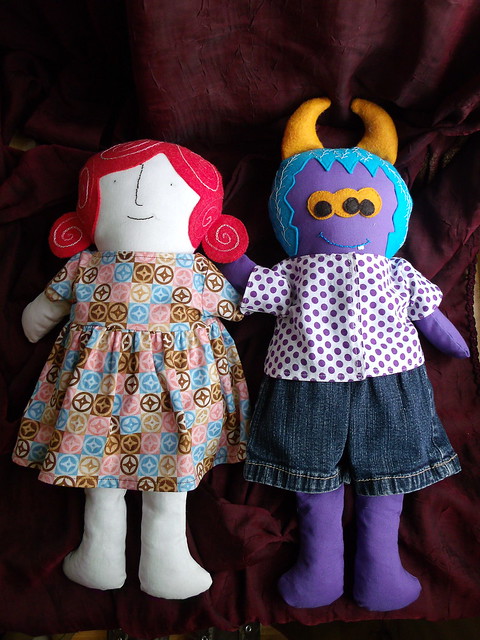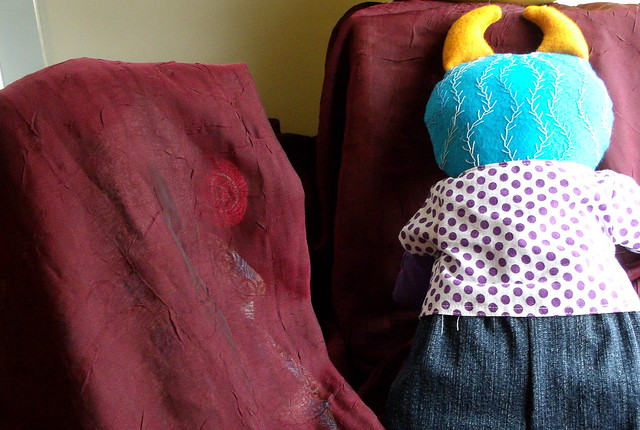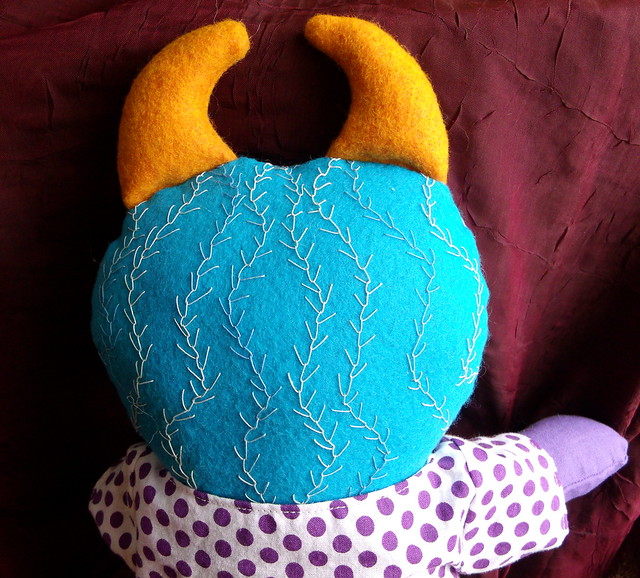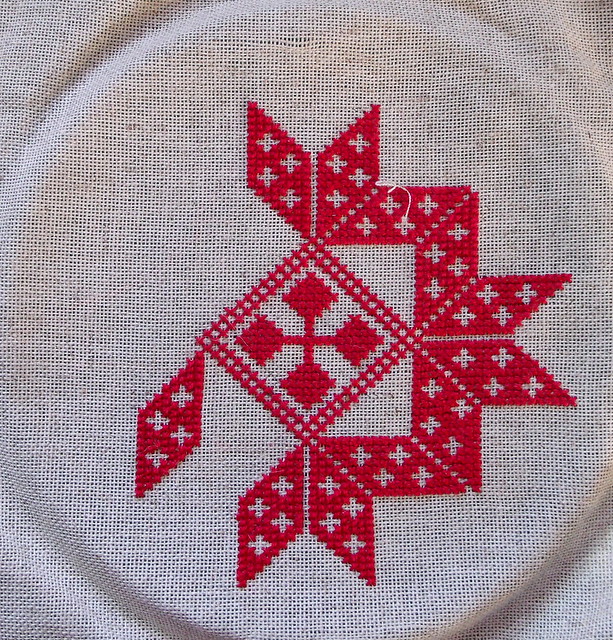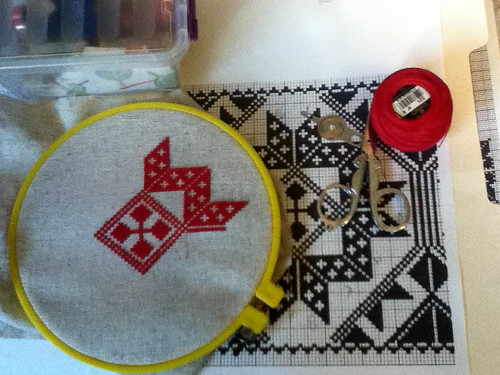I realized, when I mentioned working on the rag dolls’ hair in passing, that I never actually posted the finished monster doll. So let’s have a Halloween monster!
They seem to be getting along well. Think he’ll find her?
Hair detail — I did his hair in feather stitch and was pleased by how seaweed-y it looks:
I made them both from the Violet doll pattern from Shiny Happy World, which is part of the Dress-Up Bunch line of dolls (which are super cute). I just changed the face and hair for the monster. He sort of, um, doesn’t have a neck due to my general inexperience with drafting monster faces, but that’s okay. I mean, he has three eyes, so why not no neck?
His eyes took me three tries to get right. First I embroidered them on but wasn’t happy about how they turned out. Then I used felt the same color blue as the hair, but it looked weird somehow, as though he had those creepy blank Little Orphan Annie eyes, so I scrapped that attempt before getting to the pupils. Finally I decided to try the same color as the horns, and that one worked out perfectly. I was slightly worried about the horns suffering the kind of abuse that only a 3-year-old can visit on a stuffie, so I reinforced them a with extra lines of stitching.
The shorts are made from the pattern that came with the doll, using Wendi’s tutorial. I happened to have a pair of jeans that developed a blowout in an unfortunate spot around that time, so it worked out perfectly.
I have some more clothes to make, and I’d best get on it since my niece’s birthday is next week. I have a bunch cut out already — I finished cutting them out literally minutes before I broke my wrist, which sort of set my schedule back a bit.
At the time I made both dolls there wasn’t a monster in that line yet, and I wanted them to be able to share clothes, hence the adapted pattern. But there is a dress-up bunch monster pattern now, the uber-cute Meep who I really want to make sometime.
Another thing I’ve never posted — while I was in the cast, I started a cross stitch piece (my first ever) with the intention of making a biscornu.
It’s going fairly well so far, though I need to rip out that one section dangling by itself since it’s a half-stitch over from where it should be. I found what looks like a good set of instructions for sewing up the biscornu. I’ve never made one before, and I think they’re completely adorable. The pattern I’m using comes from an old Dover book, Charted Peasant Designs from Saxon Transylvania which I originally bought thinking some of the patterns would look really cool on colorwork mittens. The colorwork mittens haven’t materialized yet, but having that book hanging around meant I had a source of really great cross stitch designs handy when I decided that I had to start making a biscornu right that minute.
It’s a really neat book, with an introduction that talks about the Transylvania Saxons, the flow of folk textile patterns to various areas, and the recurring themes in Transylvania Saxon embroidery. There are also notes on probable origins, dates, and use of the various patterns. The one I’m working right now is taken from a pillow, with notes describing it as “Cross in eternity after Byzantine style (19th century design)”. I’m only using a piece of a larger plate. The section I’m using looks like so (please forgive the appallingly bad photo, which was taken on my ipod):
It’s a repeating design — I’m using one repeat and only including the central pattern, leaving out the corner design because it won’t fit into the size of biscornu I’m making.
Something that really struck me when I scanned the design to enlarge it and boost the contrast for my working copy is that this entire book was charted by hand. I didn’t really notice leafing through the book, but after enlarging it I could see how the filled boxes sometimes spill a bit over the line or don’t quite fill up the square. I mean, obviously in 1964 when it was published there was no Photoshop, no Illustrator, no desktop publishing software, but being so used to computers I never thought about it. The book has 195 plates, all of them fairly intricate designs. Can you imagine how many hours of work it would have been charting them all?
Update: I was poking through the Antique Pattern Library catalog and found a collection of Transylvania Saxon designs collected by Emil Sigerus. There are about forty or so designs in there, including the same one I’m working and also a couple of alphabets. It’s free, as is everything else in the APL catalog. They’re a non-profit who are doing a lot of great work scanning and distributing old public domain craft patterns and books.

